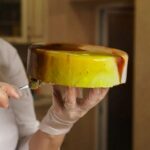Whether you’re a passionate home baker or a professional cake decorator, knowing how to make chocolate icing for cake decorating is an essential skill. Chocolate icing not only adds a delicious and decadent flavor to cakes but also serves as a versatile medium for creating stunning designs and decorations. Its rich history and enduring popularity make it a staple in the world of baking and confectionery.
The use of chocolate for icing dates back centuries, with the earliest forms being made from melted chocolate mixed with various sweetening agents. Today, there are countless variations of chocolate icings, each offering its unique taste and texture. From creamy ganache to fluffy buttercream and dense fudge icing, there is no shortage of options when it comes to choosing the perfect chocolate icing for your cake decorating needs.
In this article, we will explore the different types of chocolate icings available, outlining their distinct characteristics and suggesting which type is best suited for specific cake decorating styles. Additionally, we will delve into the essential ingredients required to create the perfect chocolate icing, providing insight into how each component contributes to its overall flavor and consistency.
Whether you’re a seasoned baker or just starting out, mastering the art of making chocolate icing will elevate your cake decorating skills to new heights. So let’s dive in and learn everything there is to know about crafting delectable chocolate icings from scratch.
Different Types of Chocolate Icings
When it comes to cake decorating, chocolate icing plays a crucial role in adding flavor and visual appeal to the finished product. There are several different types of chocolate icings that can be used, each with its own unique taste and texture. Understanding the differences between these variations can help you choose the best option for your specific cake decorating needs.
- Ganache: This luxurious chocolate icing is made by combining chocolate with hot cream to create a smooth and glossy finish. It can be used for filling, frosting, or glazing cakes.
- Buttercream: A classic choice for cake decorating, buttercream chocolate icing is made by creaming butter with powdered sugar and cocoa powder. It has a creamy texture and can be easily piped into various designs.
- Fudge Icing: This dense and rich chocolate icing is made by cooking together sugar, butter, milk, and cocoa powder. It creates a thick, fudgy layer on top of cakes.
Each type of chocolate icing offers a distinct flavor and consistency when used in cake decorating. Ganache provides a silky smooth finish, while buttercream offers a light and fluffy texture. Fudge icing delivers a dense and indulgent layer on top of cakes. Experimenting with these different options can help you find the perfect chocolate icing for your next cake creation.
In addition to the traditional types of chocolate icings mentioned above, there are also alternative recipes available for those with dietary restrictions. Vegan and dairy-free chocolate icings can be made using ingredients such as coconut oil, almond milk, or dairy-free margarine without sacrificing taste or texture. Whether you have specific dietary requirements or simply want to try something new, there are plenty of delicious options to explore when it comes to chocolate icing for cake decorating.
Essential Ingredients for Chocolate Icing
The key to making delectable chocolate icing lies in the careful selection of essential ingredients that contribute to its rich flavor and smooth consistency. Whether you’re preparing a classic buttercream frosting or a velvety ganache, each component plays a crucial role in achieving the perfect balance of sweetness and cocoa goodness.
Required Ingredients
To create a basic chocolate icing, you will need high-quality cocoa powder, melted chocolate, unsalted butter, powdered sugar, and a dash of vanilla extract. These ingredients work together to create a luscious and indulgent frosting that can be used to adorn cakes, cupcakes, and other delightful confections.
The Role of Each Ingredient
Cocoa powder is the star of the show, providing the intense chocolate flavor that forms the foundation of the icing. Melted chocolate adds richness and depth to the mixture, enhancing its overall decadence. Unsalted butter contributes creaminess and body to the icing, while powdered sugar sweetens and thickens it. Lastly, a splash of vanilla extract rounds out the flavors with its warm and aromatic notes.
Considerations for Ingredient Substitutions
For those looking to modify traditional recipes or accommodate dietary restrictions, there are various ingredient substitutions that can be made. For example, dairy-free margarine can be used as an alternative to butter in vegan recipes, while almond or coconut milk can replace traditional dairy milk for those with lactose intolerance.
Additionally, organic or raw cacao powder can be used instead of conventional cocoa powder for a more intense and natural chocolate flavor. It’s important to carefully consider these substitutions and adjust quantities as needed to maintain the desired flavor and consistency of the chocolate icing.
By carefully selecting and understanding the essential ingredients for chocolate icing, you can embark on a flavorful journey into cake decorating that will delight both your taste buds and those who have the pleasure of enjoying your delectable creations.
Step-by-Step Instructions for Making Chocolate Icing
Making chocolate icing for cake decorating requires a few simple steps and the right combination of ingredients. Follow these step-by-step instructions to create a delicious and smooth chocolate icing that will take your cakes to the next level:
- Start by melting the chocolate: Use either a double boiler or microwave to gently melt the chocolate until it is smooth and free of lumps.
- Cream together the butter and powdered sugar: In a separate bowl, cream together softened butter and powdered sugar until light and fluffy. This will provide the base for your icing.
- Add cocoa powder and vanilla extract: Once the butter and sugar mixture is well combined, add in the cocoa powder and vanilla extract. These ingredients will give your icing its rich chocolate flavor.
- Incorporate the melted chocolate: Slowly pour the melted chocolate into the buttercream mixture, mixing continuously until everything is fully combined. This step will give your icing its creamy texture and deep chocolate color.
- Adjust consistency if necessary: If your icing is too thick, you can add a small amount of milk or heavy cream to reach your desired consistency. Be sure to do this gradually to avoid making your icing too runny.
By following these step-by-step instructions, you can easily master the art of making chocolate icing for cake decorating. Experiment with different variations of this recipe to create unique flavors and textures that will impress everyone who tastes your delicious creations.
Tips for Decorating With Chocolate Icing
Decorating a cake with chocolate icing can be a fun and creative process that allows you to personalize your baked goods and add an extra touch of sweetness. There are several tips and techniques that can help take your cake decorating skills to the next level.
One popular method is using different piping techniques to create beautiful designs and patterns on cakes. For example, using a pastry bag with a star-shaped tip can create elegant swirls and rosettes, while a round tip is perfect for creating borders and writing.
In addition to piping, you can also experiment with different tools such as offset spatulas and cake combs to create unique textures on the surface of the icing. These tools can help you achieve professional-looking finishes that will impress your guests. Furthermore, incorporating additional decorations such as sprinkles, chocolate shavings, or edible flowers can add color, texture, and flavor to your chocolate icing creations.
When it comes to decorating with chocolate icing, the possibilities are endless. Whether you’re designing a birthday cake, wedding cake, or simply want to elevate a homemade dessert, don’t be afraid to let your creativity shine. With the right tools and techniques, you can turn any plain cake into a masterpiece that looks as good as it tastes.
Vegan and Dairy-Free Chocolate Icing Alternatives
For individuals with dietary restrictions such as being vegan or lactose intolerant, traditional chocolate icing may not be an option. Luckily, there are several alternative recipes that can provide the same great taste and texture without the use of dairy-based ingredients. One popular option is to use non-dairy butter or margarine as a substitute for regular butter in the recipe. This will still provide the necessary fat content while eliminating any dairy products.
Another alternative is to use plant-based milk such as almond milk or oat milk in place of regular milk in the recipe. This simple swap allows those with dairy allergies or dietary restrictions to enjoy delicious chocolate icing without sacrificing flavor or texture.
In addition to these substitutions, there are also alternative recipes that utilize ingredients like coconut cream and avocado to create rich and creamy chocolate icing that is entirely vegan and dairy-free. These recipes offer a decadent and indulgent option for those looking for a plant-based alternative for their cake decorating needs.
| Ingredients | Vegan Alternative |
|---|---|
| Butter | Non-dairy butter or margarine |
| Milk | Plant-based milk (almond, oat) |
| Cream | Coconut cream |
Storing and Preserving Chocolate Icing
Instructions for Properly Storing Leftover Icing
After making a delicious batch of chocolate icing, it’s important to know how to properly store any leftovers to maintain its freshness and flavor. The best way to store leftover chocolate icing is to transfer it into an airtight container. Make sure the container is clean and dry before adding the icing, and then seal it tightly to prevent air from getting in.
Tips for Freezing Chocolate Icing
If you find yourself with more chocolate icing than you need, freezing it is a great option for preserving it for later use. To freeze chocolate icing, place it in a freezer-safe container or resealable plastic bag. Squeeze out any excess air before sealing the container or bag to prevent freezer burn. Be sure to label the container with the date so you can keep track of how long it has been frozen.
Thawing Chocolate Icing Effectively
When you’re ready to use the frozen chocolate icing, it’s important to thaw it properly to maintain its consistency and flavor. The best way to thaw chocolate icing is to transfer it from the freezer to the refrigerator and let it thaw overnight. If you’re short on time, you can also thaw it at room temperature, but be sure to stir it well after thawing to ensure that the texture remains smooth and creamy.
By following these simple guidelines for storing and preserving chocolate icing, you can ensure that your homemade creations stay fresh and delicious for as long as possible. Whether you have leftover icing from a cake decorating project or simply want to prepare some in advance, knowing how to store and preserve your chocolate icing will save you time and effort in the long run.
Creative Uses for Chocolate Icing Beyond Cake Decorating
Once you have made your delicious chocolate icing for cake decorating, there may be leftover icing that you don’t want to go to waste. There are numerous creative and tasty ways to use chocolate icing beyond simply decorating cakes. One common use is using the leftover icing to make brownies. By swirling the chocolate icing into the brownie batter before baking, you can create a marbled effect that enhances both the flavor and visual appeal of your brownies.
In addition to brownies, you can also repurpose your chocolate icing for cookie sandwiches. Spread a generous amount of the leftover icing between two freshly baked cookies for a sweet and indulgent treat. Furthermore, if you have an excess of chocolate icing, consider making truffles by rolling small portions of the icing into balls and coating them in cocoa powder or crushed nuts for a decadent bite-sized dessert.
Another innovative way to utilize your remaining chocolate icing is by incorporating it into non-conventional desserts such as milkshakes or ice cream sundaes. In this instance, slightly warm up the frosting in order to make it pourable before drizzling it over these cold treats. This will add an extra touch of sweetness and richness to your desserts that is sure to delight your taste buds.
| Creative Use | Description |
|---|---|
| Chocolate Ganache Tart | Use it as a filling for a homemade tart crust |
| Stuffed French Toast | Spread it between slices of bread before grilling or frying |
Conclusion
In conclusion, chocolate icing plays a crucial role in cake decorating, adding rich flavor and a beautiful finish to any dessert. From the different types of chocolate icings to essential ingredients and step-by-step instructions, this article has provided a comprehensive guide for making the perfect chocolate icing at home. Whether it’s ganache, buttercream, or fudge icing, there are endless possibilities for creating delicious and visually stunning cakes.
With tips for decorating and alternative recipes for dietary restrictions, this article also emphasizes the flexibility and versatility of chocolate icing. It encourages readers to unleash their creativity with different piping techniques and decorations while also providing options for vegan and dairy-free alternatives.
Lastly, the idea of maximizing leftover chocolate icing by incorporating it into other recipes further highlights its potential beyond cake decorating. From brownies to truffles, there are countless ways to use chocolate icing in other delectable treats. This article ultimately aims to inspire readers to not only try making their own chocolate icing but also experiment with various variations and creative uses beyond traditional cake decoration. So grab your spatula and get ready to indulge in some homemade chocolate goodness.
Frequently Asked Questions
What Is the Difference Between Chocolate Frosting and Icing?
The main difference between chocolate frosting and icing lies in their ingredients and textures. Chocolate frosting is typically made with butter or cream cheese, cocoa powder or melted chocolate, powdered sugar, and vanilla extract. It has a rich and creamy texture that is perfect for spreading on cakes or cupcakes.
On the other hand, chocolate icing is usually thinner and glossier than frosting, made with chocolate, confectioners’ sugar, milk or cream, and sometimes butter. It’s often used for drizzling over pastries or as a glaze for cakes.
How to Ice a Cake With Chocolate?
To ice a cake with chocolate, start by preparing your cake layers and allowing them to cool completely. Then, spread a thin layer of chocolate icing or frosting on top of the first layer using an offset spatula. Place the second layer on top and repeat the process until all layers are stacked.
Next, apply a crumb coat of icing to seal in any loose crumbs before adding a final layer of chocolate icing. Smooth the sides and top with the spatula for an even finish.
What Frosting Is Used for Decorating Cakes?
When it comes to decorating cakes, various types of frosting can be used depending on the desired effect. For intricate designs and piped decorations such as flowers or borders, buttercream frosting is commonly used due to its smooth consistency and ability to hold its shape when piped.
Royal icing made from confectioners’ sugar and egg whites is another popular choice for delicate decorations like writing or intricate lace patterns on cakes. Fondant can also be used for covering cakes and creating sculpted designs due to its pliable nature that allows for shaping into various forms.

Welcome to my blog about home and family. This blog is a place where I will share my thoughts, ideas, and experiences related to these important topics. I am a stay-at-home mom with two young children. I hope you enjoy reading it! and may find some helpful tips and ideas that will make your home and family life even better!





